Global Odor Sensor Market Outlook - 2031
The global Odor Sensor Market size was valued at $1.5 billion in 2021, and is projected to reach $19.4 billion by 2031, growing at a CAGR of 29.4% from 2022 to 2031
An odor sensor is a device that detects and measures specific compounds in the air that create a smell, also known as volatile organic compounds (VOCs). These sensors can be used in various applications such as air quality monitoring, industrial process control, and food and beverage quality control.
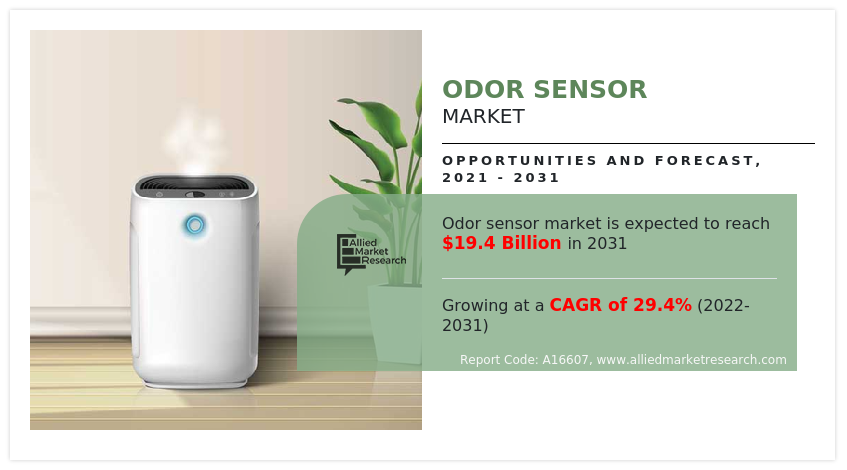
There are several types of odor sensors, and they are:
Metal Oxide Semiconductor (MOS) sensors: These sensors use a metal oxide film, such as tin oxide, to detect VOCs. They are susceptible and can detect a wide range of VOCs, but they can also be affected by humidity and temperature changes
Electrochemical sensors: These sensors use a chemical reaction to detect VOCs. They are more selective than MOS sensors but can only detect a limited number of VOCs.
Biological sensors: These sensors use living organisms, such as bacteria or yeast, to detect VOCs. They are highly selective and can detect a wide range of VOCs, but they require careful handling and maintenance.
Photoionization Detector (PID): These sensors use UV light to ionize VOCs, which are then detected by an electronic circuit. They are highly sensitive and can detect a wide range of VOCs but are also affected by humidity and temperature changes.
Infrared (IR) sensors: These sensors use infrared light to detect VOCs by measuring the absorption or reflection of infrared light by the VOCs. They are selective but also affected by humidity and temperature changes.
SAW (Surface Acoustic Waves) sensors: These sensors use mechanical waves to detect VOCs by measuring the changes in the mechanical waves caused by the VOCs. They are selective and have high sensitivity but are also affected by humidity and temperature changes.
The odor sensor Industry is expected to witness notable growth during the forecast period, owing to a rise in awareness of air pollution and its negative healthcare effects, rising demand for smart home and building automation, and growing demand for food safety and quality control. Moreover, emerging applications in healthcare and medical diagnosis are expected to provide lucrative opportunities for the growth of the odor sensors market during the forecast period. On the contrary, the high cost of odor sensors and technological limitations of odor sensors in emerging economies are some of the restraints for odor sensors market growth during the forecast period.
Segment Overview
The odor sensor market forecast is segmented into Application Areas, End Use Industries, Sensor Types, Instrument Types, and regions.
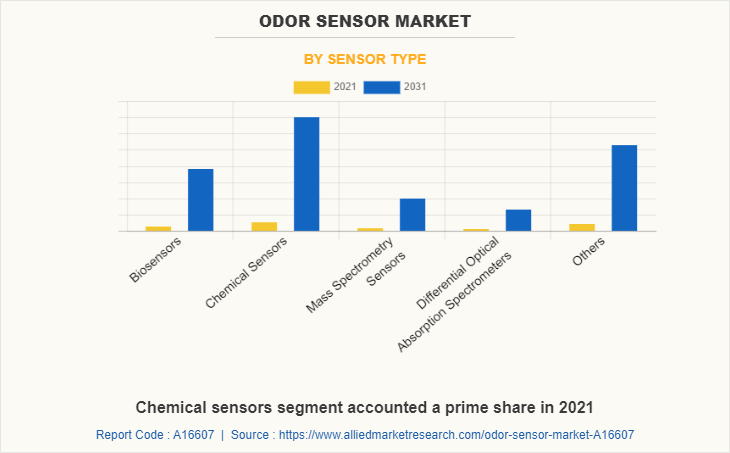
On the basis of sensor type, the odor sensor market is divided into biosensors, chemical sensors, mass spectrometry sensors, differential optical absorption spectrometers, and others. In 2021, the chemical sensors segment dominated the market, in terms of revenue, and will acquire a major market share by 2031.
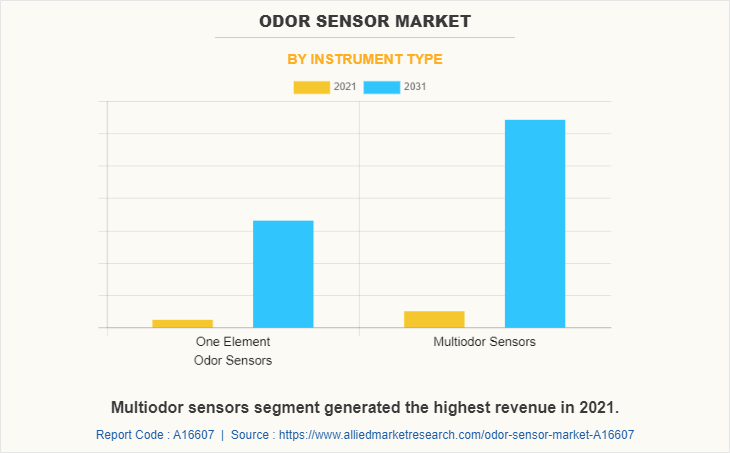
On the basis of instrument type, the odor sensor market opportunity is bifurcated into one-element odor sensors and multiodor sensors. The multiodor sensors segment acquired the largest share in 2021 and is expected to grow at a significant CAGR from 2022 to 2031.
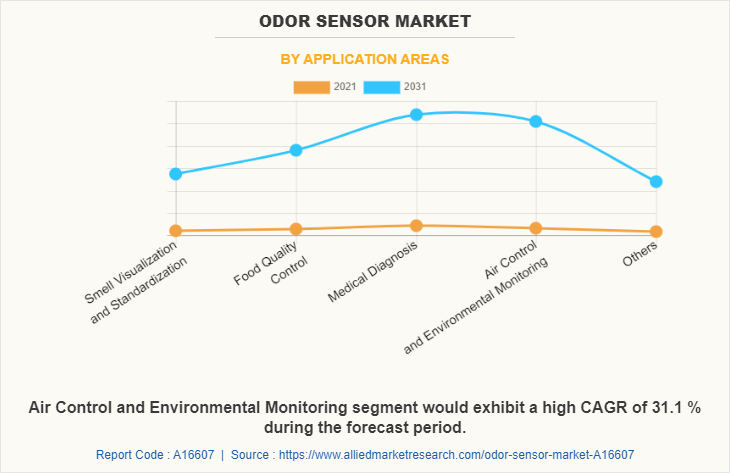
On the basis of application areas, the odor sensor market growth is segregated into smell visualization and standardization, food quality control, medical diagnosis, air control and environmental monitoring, and others. The medical diagnosis segment acquired the largest share in 2021 and is expected to grow at a significant CAGR from 2022 to 2031.
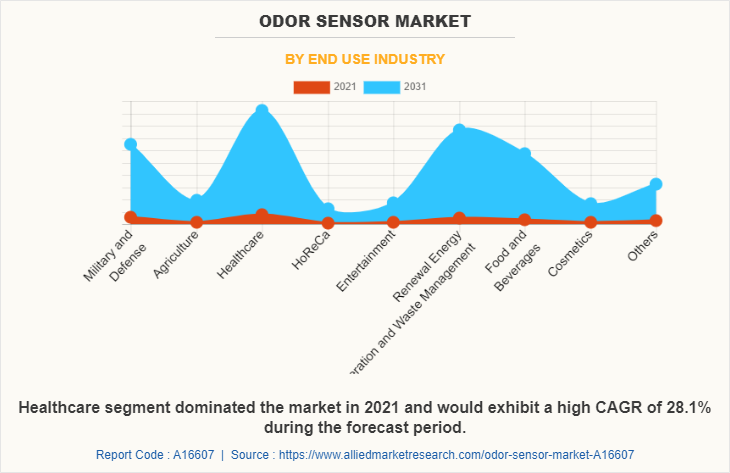
On the basis of the end-use industry, the odor sensor market outlook is segregated into military and defense, agriculture, healthcare, HoReCa, entertainment, renewal energy generation and waste management, food and beverages, cosmetics, and others. The healthcare segment acquired the largest share in 2021 and is expected to grow at a significant CAGR from 2022 to 2031.
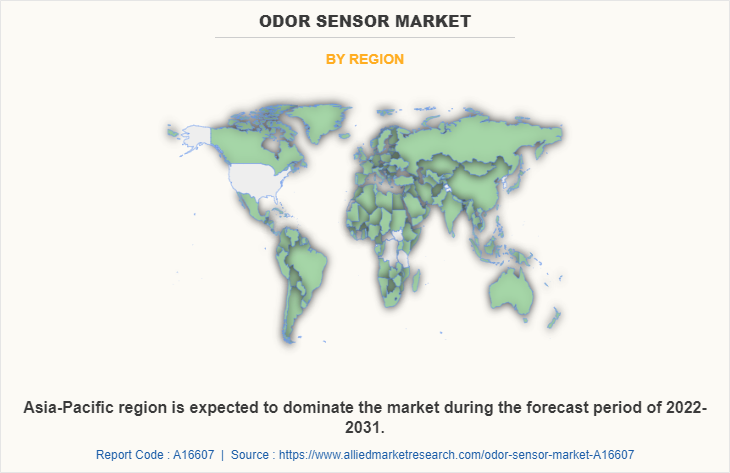
Region-wise, the odor sensors market trends are analyzed across North America (the U.S., Canada, and Mexico), Europe (UK, Germany, France, Italy, and the Rest of Europe), Asia-Pacific (China, Japan, India, South Korea, Taiwan, and Rest of Asia-Pacific), and LAMEA (Latin America, Middle East, and Africa). Asia-Pacific remains a significant participant in the odor sensor market.
Competitive Analysis
Competitive analysis and profiles of the major global Odor sensor market players that have been provided in the report include Aeroqual, Alphasense, Aryballe Technologies, Comon Invent B.V., Drager, Electronic Sensor Technology, Figaro Engineering Inc., Honeywell International Inc., Membrapor, Odotech Inc. (Envirosuite Ltd), Panasonic Corporation, and The ENose Company.
Country Analysis
Country-wise, the U.S. acquired a prime share in the odor sensor market in the North American region and is expected to grow at a significant CAGR during the forecast period of 2022-2031.
In Europe, Germany, dominated the odor sensor market, in terms of revenue, in 2021 and is expected to follow the same trend during the forecast period. However, the UK is expected to emerge as the fastest-growing country in Europe's Odor sensors with a CAGR of 30.16%.
In Asia-Pacific, China is expected to emerge as a significant market for the Odor sensors industry, owing to a significant rise in investment by prime players and government institutions to security solutions in the region.
By LAMEA region, the Latin American country garner significant odor sensor market share in 2021. The LAMEA odor sensor market has been witnessing improvement, owing to the growing inclination of companies towards research and development across this region. Moreover, the Africa region is expected to grow at a high CAGR of 31.31% from 2022 to 2031.
Top Impacting Factors
The market for odor sensors is anticipated to expand significantly during the forecast period as a result of the rise in awareness of air pollution and its negative healthcare effects, rising demand for smart home and building automation, and growing demand for food safety and quality control. Additionally, during the forecast period, the Odor sensor market is anticipated to benefit from emerging applications in healthcare and medical diagnosis. On the other hand, growth in the odor sensor market is expected to be constrained by the high cost of odor sensors and technological limitations of odor sensors in emerging economies.
Historical Data & Information
The global Odor sensor market is highly competitive, owing to the strong presence of existing vendors. Vendors of Odor sensors with extensive technical and financial resources are expected to gain a competitive advantage over their competitors because they can cater to market demands. The competitive environment in this market is expected to worsen as technological innovations, product extensions, and different strategies adopted by key vendors increase.
Key Developments/ Strategies
Aeroqual, Alphasense, Aryballe Technologies, Comon Invent B.V., Drager, Electronic Sensor Technology, Figaro Engineering Inc., Honeywell International Inc., Membrapor, Odotech Inc. (Envirosuite Ltd), Panasonic Corporation, and The ENose Company are the top companies holding a prime share in the Odor sensor market. Top market players have adopted various strategies, such as product launches, acquisitions, innovation, partnerships, and others to expand their foothold in the Odor sensor market.
In February 2022, Envirosuite, a developer of real-time, predictive, and diagnostic environmental management software, installed odor monitoring devices, as part of a city-funded study, to find the source of noxious odor neighbors have complained about for years. The study will be tracking volatile organic compounds, styrene and pinene.
In May 2022, Dwyka Mining Services introduces a new robotic solution that is equipped with odor sensors to detect harmful gases in the mines. This technological advancement has benefited the company to establish mobile technology for broader applications and the safety of the labors.
In October 2021, Figaro announced products for its brand-new Methane. The sensor is TGS8410. This sensor is the best for battery-operable methane gas detectors.
In August 2021, Figaro introduced the evaluation module, EM3870B. This module facilitates the evaluation of the characteristics of the TGS3870 gas sensor for the detection of both methane and carbon monoxide.
In August 2021, Figaro announced TGS2603 MOS-type, odorous gas sensor. It is widely used for indoor air quality monitoring and odor detection.
In July 2021, Panasonic launched the Laser Type Particulate Matter Sensor which has a very small footprint of W37 x D37 x H12 mm, and can be used to detect a wide variety of particulate matter including but not limited to dust, fly ash, soot, smoke, aerosols, fumes, mists, and condensing vapors, solid fuels, construction materials, cooking/smoking of plant matter, fireplaces and furnaces, house/forest fires, waste incineration and much more.
In November 2020, Honeywell expanded its holistic healthy buildings' air quality offering to help improve and measure commercial building indoor air quality with the introduction of Honeywell Electronic Air Cleaners (EACs) with UV Systems and a line of indoor air quality (IAQ) sensors. Honeywell EACs with UV help remove impurities from the air as well as provide filtration and disinfection, without significantly impeding air flow.
In January 2020, Aryballe announced a high-volume, low-cost universal odor sensor, capable of detecting any odor in near real-time. Built on a silicon photonics platform, the sensor of Aryballe is ideal for the automotive and consumer appliances industries
Key Benefits For Stakeholders
- This report provides a quantitative analysis of the market segments, current trends, estimations, and dynamics of the odor sensor market analysis from 2021 to 2031 to identify the prevailing odor sensor market opportunities.
- Market research is offered along with information related to key drivers, restraints, and opportunities.
- Porter's five forces analysis highlights the potency of buyers and suppliers to enable stakeholders to make profit-oriented business decisions and strengthen their supplier-buyer network.
- An in-depth analysis of the odor sensor market segmentation assists in determining the prevailing market opportunities.
- Major countries in each region are mapped according to their revenue contribution to the global market.
- Market player positioning facilitates benchmarking and provides a clear understanding of the present position of the market players.
- The report includes an analysis of the regional as well as global odor sensor market trends, key players, market segments, application areas, and market growth strategies.
Odor Sensor Market Report Highlights
| Aspects | Details |
| Market Size By 2031 | USD 19.4 billion |
| Growth Rate | CAGR of 29.4% |
| Forecast period | 2021 - 2031 |
| Report Pages | 341 |
| By Application Areas |
|
| By End Use Industry |
|
| By Sensor Type |
|
| By Instrument Type |
|
| By Region |
|
| Key Market Players | Odotech Inc. (Envirosuite Ltd), Drager, Comon Invent B.V., Electronic Sensor Technology, Panasonic Corporation, Aryballe Technologies, Honeywell International Inc., Alphasense, Membrapor, Aeroqual, The eNose Company, Figaro Engineering Inc. |
Analyst Review
The market is expected to grow significantly in the coming years due to an increase in demand for air quality monitoring, food safety, and environmental protection. Other factors that drive the growth of this market include a rise in awareness about the harmful effects of pollutants, growth in the demand for smart homes, and an increase in government regulations and standards for air quality monitoring.
Other factors that contribute to the growth of the odor sensor market include advancements in technology which leads to the development of more accurate and efficient sensors, growth in demand for odor sensors in various end-use industries such as agriculture, waste management, and water treatment and increase in the use of odor sensors in heating, ventilation, and air conditioning (HVAC) systems for indoor air quality control. Furthermore, the growth in the need for real-time monitoring and early detection of gas leaks in industrial and residential areas and the rise in awareness about the health effects of indoor air pollution leads to greater demand for odor sensors.
Furthermore, the market for odor sensors and other types of sensors is generally expected to grow in the coming years due to demand for odor sensors in the automotive industry for air quality monitoring in vehicles. In addition, the growth of the smart cities market leads to an increased demand for odor sensors in various applications, such as smart homes, smart buildings, and smart industrial systems; and growth in demand for odor sensors in the healthcare industry for patient monitoring and diagnostic purposes is anticipated to boost the odor market during the forecast period.
Asia-Pacific remains a significant participant in the odor sensors market.
The market for odor sensors is anticipated to expand significantly during?the forecast period as a result of the rise in awareness of air pollution and its negative healthcare effects, rising demand for smart home and building automation, and growing demand for food safety and quality control.
Aeroqual, Alphasense, Aryballe Technologies, Comon Invent B.V., Drager, Electronic Sensor Technology, Figaro Engineering Inc., Honeywell International Inc., Membrapor, Odotech Inc. (Envirosuite Ltd), Panasonic Corporation, and The ENose Company are the top companies holding a prime share in the Odor sensors market.
The medical diagnosis segment acquired the largest share in 2021 and is expected to grow at a significant CAGR from 2022 to 2031.
The global odor sensor market was valued at $1,462.1 million in 2021, and is projected to reach $19,437.2 million by 2031, registering a CAGR of 29.37% from 2022 to 2031.
Loading Table Of Content...



